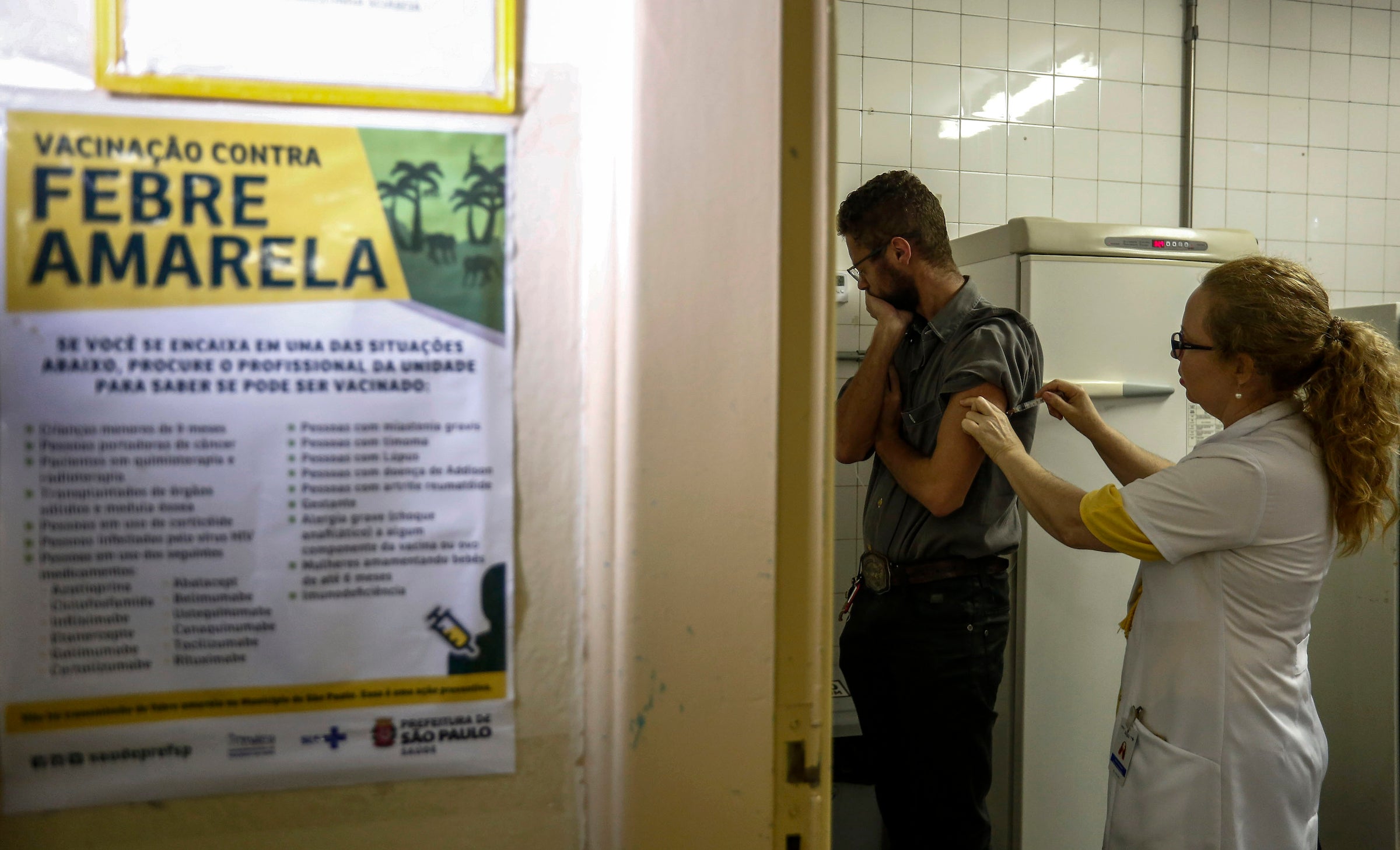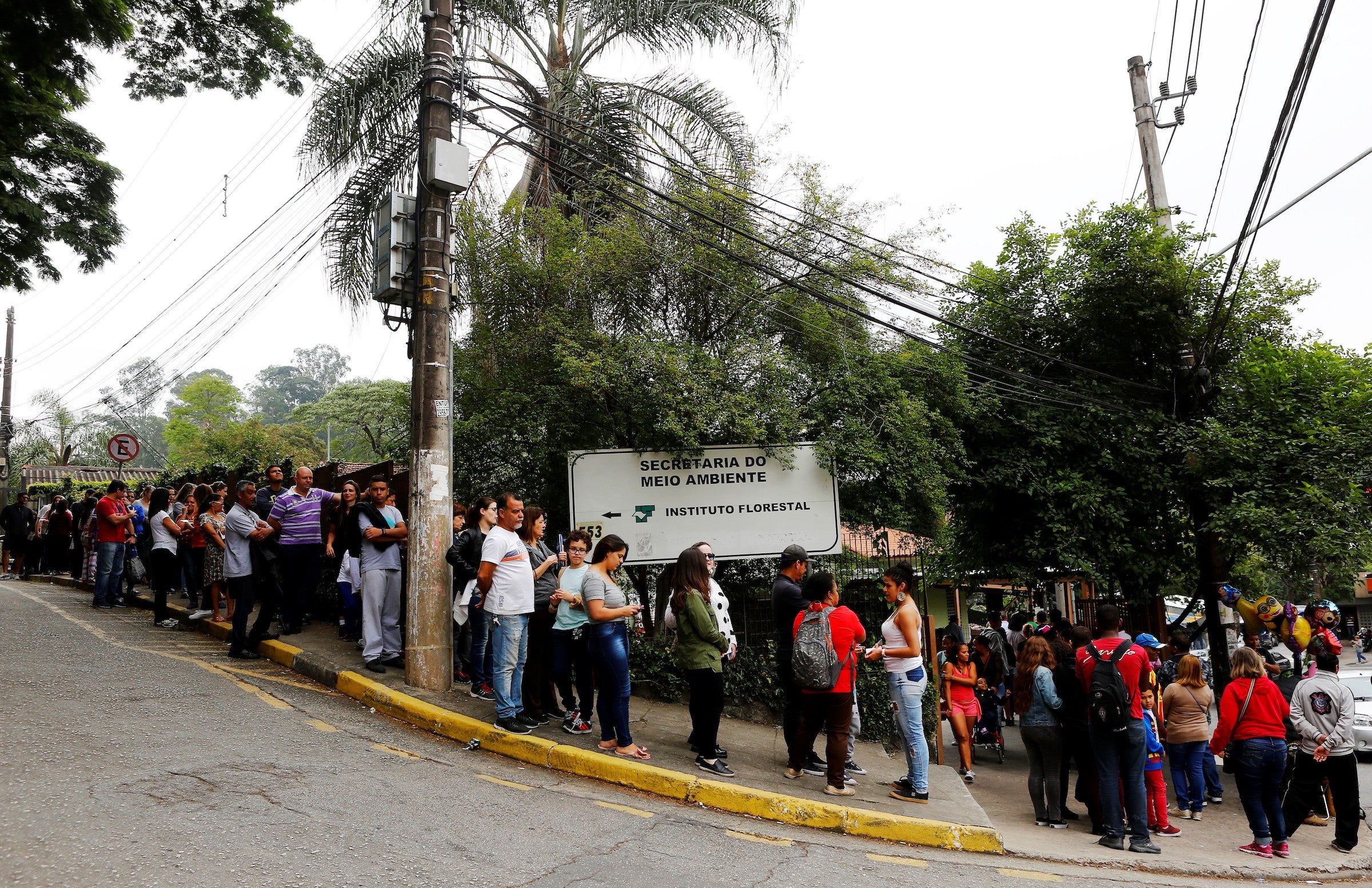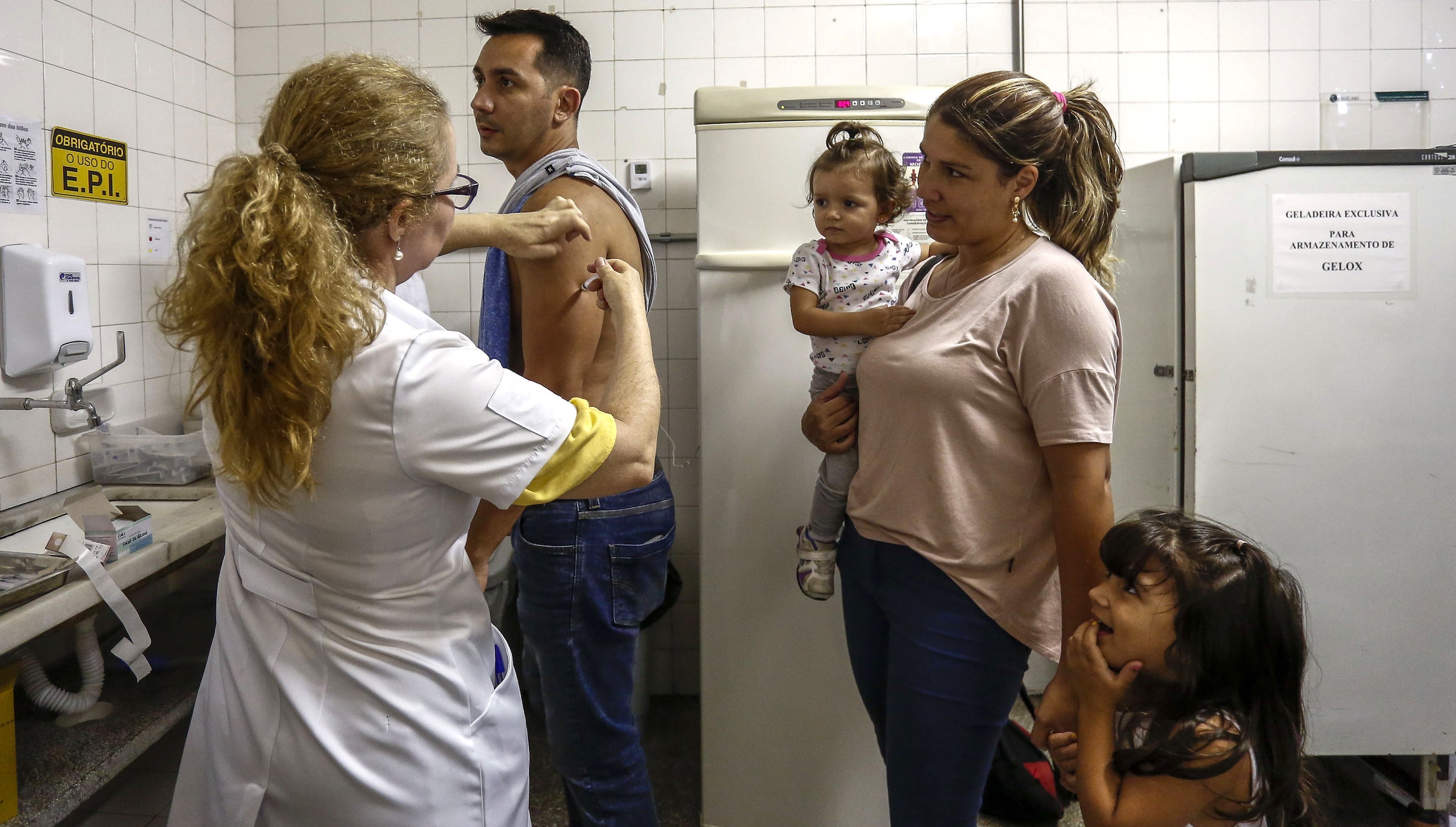Brazil yellow fever vaccination efforts hampered by rumours, fear and social media
With 237 deaths this season already, officials are concerned the fatality rate will explode if the virus reaches the slums and the clouds of mosquitoes waiting there

Your support helps us to tell the story
From reproductive rights to climate change to Big Tech, The Independent is on the ground when the story is developing. Whether it's investigating the financials of Elon Musk's pro-Trump PAC or producing our latest documentary, 'The A Word', which shines a light on the American women fighting for reproductive rights, we know how important it is to parse out the facts from the messaging.
At such a critical moment in US history, we need reporters on the ground. Your donation allows us to keep sending journalists to speak to both sides of the story.
The Independent is trusted by Americans across the entire political spectrum. And unlike many other quality news outlets, we choose not to lock Americans out of our reporting and analysis with paywalls. We believe quality journalism should be available to everyone, paid for by those who can afford it.
Your support makes all the difference.“Good morning!” a loudspeaker blares in the working-class Sao Paulo suburb Jardim Monte Alegre. “We’ve got your yellow fever vaccine, and today we’re going house to house! You better wake up because mosquitoes never sleep!”
Twenty health workers pile out of cars. Though they laugh and chat with residents, their mission is deadly serious.
Brazil is suffering its worst outbreak of yellow fever in decades. The virus, which kills 3 to 8 per cent of those who are infected, is circling the megacities of Rio de Janeiro and Sao Paulo, threatening to become the country’s first urban epidemic since 1942.
There have been 237 deaths since the hot season began, and the fatality rate will explode if the virus reaches the slums and the clouds of Aedes aegypti mosquitoes swarming there.
A aegypti – known for centuries as the fearsome “yellow fever mosquito” – is also the chief spreader of Zika, dengue and chikungunya. It breeds in drinking water barrels and street garbage puddles, hides in the dark corners of houses and often bites several humans before laying eggs.
To head off that catastrophe, health officials are struggling to vaccinate 23 million people. But the effort has been slowed by what critics call government missteps and false rumours about the vaccine.
“When they stopped coming to us, we started going to them,” says Nancy Marcal Bastos, health and sanitation director for northern Sao Paulo. “People have a lot of excuses for why they haven’t gotten the vaccine yet, but when we show up, it’s usually easy to convince them.”
Toting coolers full of vaccines, health workers stop in the corner bar and the local gym, demanding: “Who hasn’t been vaccinated yet? Line up!” The workers jab extended arms and fill out forms with surprising speed, then move house to house.
The challenges are daunting.
In early 2016, the yellow fever virus broke out of its usual pattern: limited spread by forest mosquito species from monkeys to loggers, hunters, farmers and other residents of the Amazon basin. Instead, the virus began moving south and east, following forest corridors inhabited by monkeys towards the big coastal cities and triggering a public health emergency.

Panicky Brazilians started shooting, clubbing and poisoning monkeys in the belief that this could slow the spread. Actually, authorities said, that hurt efforts to track the virus, because monkey deaths are used as an indicator of its direction.
Last year, it did not quite reach the cities – cases faded out by July as cooler weather set in. Global health authorities sighed with relief, hoping intense vaccination efforts would snuff the outbreak.
But that didn’t happen, says Dr Sylvain Aldighieri, chief of epidemic response for the Pan American Health Organisation.
“There was lab-confirmed transmission during the winter,” he says. “So the amount of virus around at the beginning of the summer was already huge.”
Most of these new cases are occurring in areas where, until now, we didn’t recommend immunisation
The resurgent virus is now lunging forwards more than a mile a day, he says, and efforts to stop an epidemic have become a race between the virus and the vaccinators.
This year’s caseload is 26 per cent higher than at this time last year, and with more hot, rainy months ahead, the figure is destined to increase.
This year, yellow fever – named for its most common symptom, jaundiced eyes and skin – began killing foreign tourists, including visitors to Ilha Grande, a tropical island south of Rio. Two Chileans and a Swiss citizen died, and visitors from France, the Netherlands and Romania fell seriously ill.
In January, just before carnival season, another tourism lure, the US Centres for Disease Control and Prevention raised its alert level, advising Americans headed for Rio, Sao Paulo and several other areas to be vaccinated first.
Brazil makes its own vaccine through a subsidiary of its Oswaldo Cruz Foundation. Much of this year’s chaos could have been averted if the government had acted faster, critics say. Low oil prices have hurt every sector of the economy, and the country has had a series of distracting political crises.

“Brazil’s public health response was very delayed,” says Dr Karin A Nielsen, an infectious disease expert at the University of California, Los Angeles, who conducts research in Brazil. “Monkeys were dying in the wild two to three years ago.”
Dr Jesse Reis Alves, a travel medicine specialist here, says the vaccination campaign should have been launched “in a calm moment between outbreaks”. Instead, he says, “they waited for a new outbreak”.
In September, vaccinations were given to people living around forests near Sao Paulo where dead monkeys were found; the suburbs were targeted only in November.
Initially, long lines formed at clinics, and 85,000 shots were given in one weekend. Then, on Facebook, YouTube and other social media platforms, anti-vaccine activists – who had found little footing in Brazil – began spreading terrifying rumours.
“Some people began trashing the vaccine, saying, ‘It’s going to kill you’,” says Dr Ernesto TA Marques Jr, an expert in mosquito-borne diseases at the University of Pittsburgh. “It was picked up in the media.”
When they stopped coming to us, we started going to them. People have a lot of excuses, but when we show up, it’s easy to convince them
The vaccine, invented in the 1930s, is highly effective – one dose normally provides lifetime protection. But it is not harmless. It cannot be given to newborns or anyone with a compromised immune system. It is given to people older than 60, pregnant women, or children younger than 8 months only when the risk of infection is high.
About one recipient in 100,00 suffers a dangerous reaction like jaundice, hepatitis or encephalitis, Marques says, and about one in one million dies. “If you vaccinate 30 million people, you’ll get about 30 deaths,” he says.
But if yellow fever infected 30 million people, two million could die.
So, with the disease moving rapidly forwards, health authorities announced that they hoped to inoculate 95 per cent of the population in 77 cities and towns in the virus’s path – a total of 23 million people, including 12 million in this city alone.
But “they didn’t have 12 million shots to give us”, says Dr Wilson M Pollara, Sao Paulo’s health secretary. “So we’re doing it in phases – two million at a time.”

The global vaccine stockpile, overseen by the World Health Organisation, normally contains only six million doses, made by only four manufacturers, including the Cruz foundation. But Brazil has increased production to about five million doses per month and can soon double that, says Dr William Perea, the WHO’s epidemic control coordinator.
That should easily cover Brazil’s needs for now, he says, so the global stockpile will not be drawn down. If necessary, it can be replenished; the four makers together can turn out 100 million doses a year in an emergency, he says.
To stretch its initial supply of the vaccine, Brazil gave out one-fifth of the doses. That provides protection for at least a year and can be used in emergencies, the WHO says.
Thus far, however, only 5.5 million people have been vaccinated. Despite those low numbers, the Health Ministry has pushed back against critics, insisting it followed international procedures.
“I don’t think there were mistakes or delays,” says Dr Renato Vieira Alves, the ministry’s communicable disease coordinator. “You can’t launch new vaccination campaigns in an instant.”
While the caseload is higher than last year’s, it is only a fraction of the population at risk, he argues. “Most of these new cases are occurring in areas where, until now, we didn’t recommend immunisation,” he says.
To overcome suspicion of the vaccine and frustration with long lines at clinics, vaccinators have started going door-to-door or using tents shifted from one neighbourhood to another. There, they hope face-to-face chats will succeed where other efforts have failed.
Lucia Elena de Paula, 36, explains her fears to a nurse, saying: “I saw a video on WhatsApp with a girl who says she was paralysed after taking the vaccine.”
But after a few soothing words from a staff member, she agrees to get the shot.
After dragging her 10-year-old grandson into a gym where the vaccines sit on an exercise bench, Aparecida Caldeira, 61, says: “When we went to the clinic in January, the lines were just too long. I’m so grateful they came here. But that’s just typical in Brazil – waiting to do everything at the last minute.”
© New York Times
Join our commenting forum
Join thought-provoking conversations, follow other Independent readers and see their replies
Comments